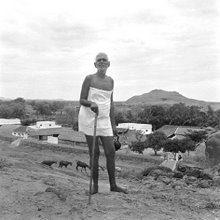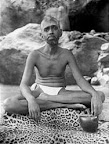Much before darkness envelops the earth the rays of the sun are withdrawn and the sun sets to the regret of the world.
During the Virupaksha days, the Skandasramam days and the early years of stay at Ramanasramam Bhagavan's body glowed brilliantly. Later, except on the occasions of Deepa utsavam, Mahapooja and Bhagavan's Jayanti, that glow disappeared. Several interpretations were put on this; such as that it was an indication of the approaching withdrawal or that in the ruined physical frame of Bhagavan it could not be manifest and the like.
Astrologers said that the end was approaching. The Nadi grantha mentioned that Ramana Leela would go on till Bhagavan was eighty. The learned questioned whether the planets had any influence on a jnani [?]. Some quoted the saint composer Tyagaraya who said, "If Rama's anugraha (grace) is there, what do the grahas (planets) matter?" Yet others contradicted this saying, "Bhagavan is totally indifferent towards the body so the influence of planets is bound to be there."
Bhagavan said on a number of occasions, "This (the body) has come into being according to your desire." He meant the devotees' desire. He also added, "It will go if you
do not need it." This meant that Bhagavan's life was entirely dependent on the wishes of others. If that be so, another question could arise ? "Who is it that says the body's work is no longer needed?" There can be no answer to it.
Owing to the neglect of the body during its youth it began showing the consequences from 1945 itself. With the passing away of Echammal (1945) the consequences became clearer. Even earlier, Bhagavan had asthma and pains in the joints during winter. Therefore, he avoided sweets and buttermilk sometimes. While it can be philosophised that nobody lasts for ever, it can still be argued that if there was a reason for the body's coming into being there should be one for its exit also.
In the present case, it would be more appropriate to say that the purpose of the avatar had been fulfilled. As Kavyakantha said in Ramana Gita, the purpose was to demonstrate to the world that abidance in the Self and Liberation were attainable. Bhagavan demonstrated this for over half a century. Seekers came from far to serve at the feet of Bhagavan and his message had travelled to distant lands. His grace was experienced by devotees, yogis, jnanis and disciples according to their deserts. "Anyone who came here did not go empty-handed."
"Bhagavan takes upon himself the fruits of devotees'
karma [?], which is why he suffers so many bodily ailments" ? who can answer such comments? It is possible that Bhagavan took upon himself the sufferings of the devotees. A devotee by name Krishnamurthy was suffering from a painful index finger but sat silently in Bhagavan's presence without revealing
it. All of a sudden Bhagavan began rubbing his own index finger. The next moment the devotee's pain disappeared.
Ever since 1947, Bhagavan's deteriorating health became a cause of anxiety to his devotees. His rheumatic pain extended to his waist and back. Maybe, for a weakening body better nutritious food was necessary but Bhagavan did not approve of any special treatment for himself. On top of it he would say: "The body itself is a disease. One should enquire into the origin of the disease, not look for ways to lessen the effect of the disease which this disease (the body) contracted." Thus he would make fun of those who brought medicines for him.
Ramachandra Rao, an Ayurvedic physician from Bangalore, once brought a list of items for preparing Ayurvedic medicines and showed it to Bhagavan. Bhagavan went through the list and spoke well of each item. Taking the cue, Ramachandra Rao asked Bhagavan, "Do I have Bhagavan's permission to go ahead with the preparation of the medicines?"
Bhagavan:
Medicines? For whom?
Ramachandra: For Bhagavan Bhagavan:
Why for me? I am alright. You appear to be weaker than me, you had better take the medicine yourself.
Another devotee also suggested that Bhagavan should take tonics. Bhagavan replied, "Am I a rich man to be able to afford tonics? All that I do is to go in when the bell rings and eat the food granted to me."
Another devotee said to Bhagavan, "Sri Aurobindo has milk, fruits and almonds," (implying that Bhagavan also should do something on those lines). Bhagavan's reply was "Why not? He is fairly well-to-do. What do I have?"
Bhagavan was always the first one to serve devotees who fell sick. He was capable of curing their diseases in a moment by his grace but it was the misfortune of the devotees that he never thought of curing himself so that hundreds of devotees could continue to experience his grace.
The authorities of the Ashram never asked Bhagavan to cure himself for their sake. But they fetched doctors who gave medicines, and performed surgery on the body as if it were like any other body. By the time they realized the truth it was too late.
On several earlier occasions Bhagavan cured himself of ailments such as jaundice. On that occasion, the medication of doctors did not prove effective. So also when he had unceasing hiccups. Once Bhagavan had eczema both on the legs and back. Dr. Melkote tried several medicines for two months but failed. Finally with tear- filled eyes and a choked voice he begged of Bhagavan to cure himself. Within two days Bhagavan cured himself. Is not Bhagavan a physician for the disease called the cycle of birth and death (bhavaroga bhishak vara)?
May be it did not strike the devotees that towards Bhagavan's end the only way of keeping him amidst themselves was to surrender to Bhagavan.
In February 1949, a small `boil' appeared on the left forearm of Bhagavan which he ignored. But the doctors
did not; they felt that unless it was removed at once surgically it could cause trouble. On the evening of 9 February 1949, Dr. Sankara Rao, with the assistance of Dr. Srinivasa Rao, removed the boil in the bathroom of Bhagavan. Before the surgery Bhagavan did ask, "Won't this go by simply bandaging with a few leaves?" But the doctors said, "The sarvadhikari also has approved of our proposal." Thereafter, Bhagavan kept quiet. After a week's bandaging the wound healed and the bandage was removed.
The boil re-appeared and within a month increased in size causing anxiety to everyone. This time a noted surgeon, Dr. Raghavachari from Madras was summoned. He operated on the tumour on 27 March 1949 after giving a local anaesthetic. As the tumour arose on the nerve a deep cut became necessary. A biopsy was done and sent for investigation. The wound did not heal, on the contrary it spread. The results of the biopsy arrived by mid-April. It was diagnoised as sarcoma. Radium treatment was then resorted to. The tumour did not heal but it began bleeding. A blood transfusion was done on 30 April. Finally Dr. Raghavachari suggested amputation of the forearm which Bhagavan rejected outright saying, "I will look after myself." On another occasion, he quipped: "If the tumour were to arise on the head they would perhaps suggest removal of the head." Devotees who could not bear the thought of Bhagavan's forearm being removed drew hope from his assurance that he would look after himself.
On 8 May 1949, a well-known Ayurvedic physician, Dr. Lakshmipathi, suggested that bandaging with certain
leaves would be beneficial. Another doctor of Bangalore, Dr. Ramachandra Rao also made a similar suggestion. Hearing this, a devotee wondered if the problem could be so easily solved. But Bhagavan said, "He is a doctor, he should know." Yet again someone suggested that Bhagavan could cure himself by his sankalpa [?] to which Bhagavan replied "Did I invite it for it to vanish at my bidding?"
Possibly as a result of Dr. Lakshmipathi's suggestion Valluvai Tata, a native `doctor' who knew all about medicinal leaves, was summoned on 5 July 1949. This was the same person who had healed Bhagavan's fractured collar bone while on Arunachala. He tied a particular bandage saying a tumour like that ought not to have been operated. This bandage reduced the bleeding. But the `doctor' was keen on removing the `poison' in the tumour and applied hot chilli powder to the wound. Even under normal circumstances such an application would be unbearable to anyone, in Bhagavan's condition it was intolerable. His temperature shot up. With that the native `doctor' was asked to stop his attempts.
On 25 July 1949 another well-known physician Dr.
Guruswami Mudaliar visited Bhagavan and expressed displeasure at the carrying out of the operation. He suggested administering certain injections and left promising to visit again.
Meanwhile several Vedic pandits commenced some special poojas and Surya namaskars for Bhagavan's recovery. Some devotees like Suri Nagamma also joined them. Bhagavan did not prevent them but said, "Let them do
what they wish, after all it is something good." He also said on another occasion, "What is the use? The atma in Surya is here also."
In August, administering of penicillin injections commenced. The timings for Bhagavan's darshan were also restricted as he needed rest. In November, Dr. Guruswami Mudaliar paid another visit and after consulting the doctors decided that another operation was necessary. Bhagavan was taken to the Ashram dispensary the following day. A blood transfusion was done and after administering anaesthesia the tumour was cut with an electric knife to minimize bleeding.
Anxious crowds collected round the Ashram
dispensary. To keep some order, volunteers and police were deployed. At the request of Swami Niranjanananda the crowds began dispersing. In the evening after 6 p.m. Bhagavan was seated in the verandah of the hospital to grant darshan to the devotees.
The next day, Bhagavan himself walked to the hall to give darshan. The hopes of the doctors were restored. Radium therapy was resumed and it appeared as if the wound was healing. But in December things took a turn for the worse with the appearance of another tumour a little above the place where the earlier tumour arose. The doctors operated this also on December 19 but with no results.
Thereupon the doctors gave up. The anxiety of the devotees mounted and they began asking themselves whether the jyoti would last beyond a few days.
Referred Resources:
Links to letters:
Echamma: (Chapter 15: Echamma’s Demise
tumour: (Chapter 273: Brahmanirvana
1949: (Chapter 273: Brahmanirvana
Dr. Guruswami Mudaliar: (Chapter 273: Brahmanirvana
Lakshmi: (Chapter 193: The Deliverance of Lakshmi the Cow
Lakshmi: (Chapter 194: Burial of Lakshmi the Cow
Lakshmi: (Chapter 195: The History of Lakshmi the Cow
Valluvai: (Chapter 273: Brahmanirvana
Dr. Sankara Rao: (Chapter 273: Brahmanirvana
prarabdha: (Chapter 116: Prarabdha (Fate)
Dr. Srinivasa Rao: (Chapter 273: Brahmanirvana
Links to rl:
Virupaksha: (Chapter 18: The Peerless Hill
Ramana Gita: (Chapter 27: Sri Ramana Gita
Lakshmi: (Chapter 34: Followers
Lakshmi: (Chapter 40: Withdrawal of the Manifestation
Suri Nagamma: (Chapter 34: Followers
Kavyakantha: (Chapter 22: Ganapati Muni
Echamma: (Chapter 21: Echammal
Echamma: (Chapter 40: Withdrawal of the Manifestation
Links to sp:
Dr. Sankara Rao: (Chapter 54: Treatment to Sri Bhagavan - An Account -- Dr. Shankar Rao
Links to gems:
Liberation: (Chapter 8: Self-Realization
destiny: (Chapter 11: Fate and Freewill





No comments:
Post a Comment